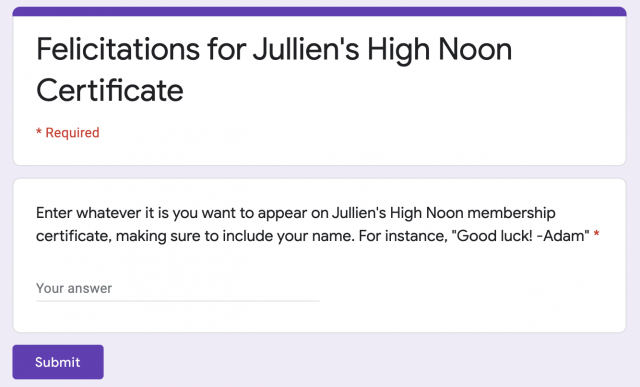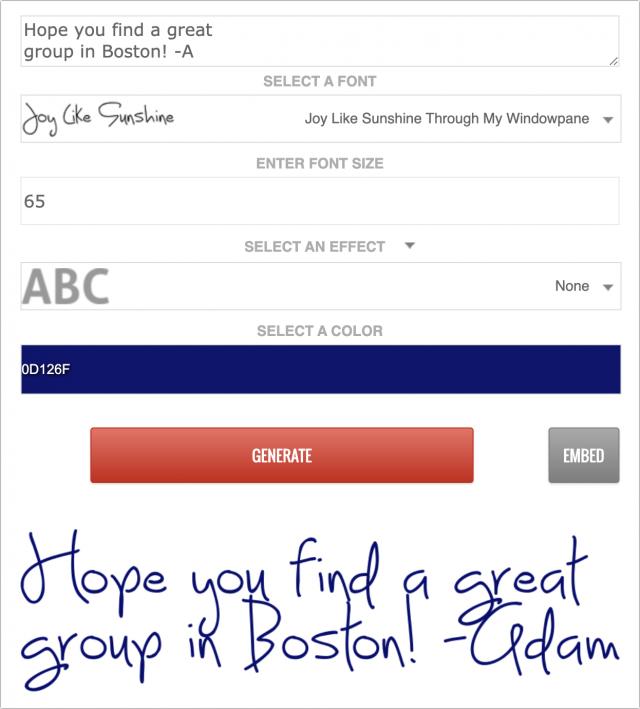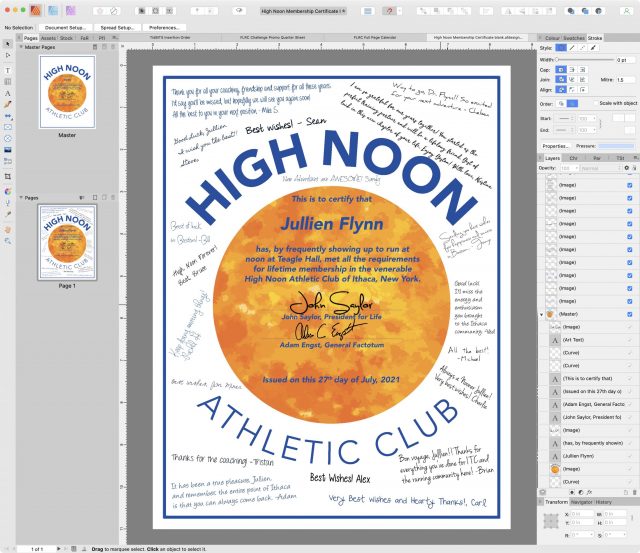A Solution for Group “Best Wishes” Certificates During the Pandemic
The High Noon Athletic Club that I run with has a tradition, or at least it did before the pandemic. To commemorate when one of our regulars moves away, we mark the event with a “last run,” complete with libations at a nearby creek and a membership certificate that was secretly passed around in the locker room for the rest of the group to affix their best wishes. One of our members recently completed her PhD and was headed off for a postdoc at MIT, but since noontime runs aren’t yet happening regularly, there was no way to collect signatures.
Rather than let another tradition fall prey to the pandemic, I came up with a solution that I’d like to share in case anyone else finds themselves in a similar situation. My approach had to meet a few requirements:
- People had to be able to write whatever message they wanted.
- The messages on the membership certificate had to look handwritten, but not as though they were all written by the same person with the same pen.
- It couldn’t require any time-consuming graphics work in cleaning up scanned or photographed messages.
To collect the messages, I set up a Google Form with a single short answer question and sent the link to the club mailing list. I encouraged people to keep their messages brief, though I wasn’t surprised when a few got wordy.
Many people don’t realize that Google Forms can save responses to a Google Sheet, making it easy to work with the data after the fact. That got me the data I needed, in a form that made it easy to copy and paste.
The linchpin for the project was Font Meme’s Text Graphic Generator for Handwriting Fonts. It let me enter some text, choose from a wide variety of handwriting fonts, and pick a color, after which it turned my text into a PNG graphic. Once I was satisfied, it was easy to Control-click the graphic and choose Copy Image.
Next, I opened our membership certificate in Affinity Publisher. (I’m converting all my projects from Adobe InDesign and Adobe Illustrator to Affinity Publisher and Affinity Designer because they each cost about the same as a single month of Adobe’s Creative Cloud). I pasted the message in, resized it to fit in an empty area, and angled it so it looked more like someone was trying to fit it into a particular spot. Then I repeated the process with all the other messages, choosing a different font for each. I had to insert returns into a few of them to make them more vertical than horizontal, and for some, I changed the color from black to blue to simulate people writing with different pens. It took a little work to resize and arrange them all in a realistic fashion, but the end result came out great and was significantly cleaner (and less sweat-stained) than our usual efforts.
This little project is far from being a cure for cancer, but it was a good feeling to be able to leverage various tools to do something nice for a departing friend. I hope others find it helpful as well.



Nice job Adam, I hadn’t thought of using Google Forms/Sheets to gather this kind of material before but a good suggestion. Also have become a firm fan of Affinity Publisher, haven’t loaded ID in months.
Why is using Google Forms for this better than sending an email using Bcc:? I haven’t used Google Forms before.
In this case, email would have been a lot of wrangling. I kept the certificate a secret by setting my friend’s email subscription to NOMAIL in the mailing list manager, sending the message soliciting signatures (with an admonition to not reply), and then restored her subscription. So I could have asked people to send me their messages in email, but then I would have had 20 separate messages to receive, track, and probably reply to. Plus, I think people would have written a lot more because they would have been in the context of email, where long-form notes are fine.
By using Google Forms, the messages stayed short and were all automatically collected in the Google Sheet, making it super easy to copy and paste into the Font Meme tool, one after another. If I’d been doing that in email, I would have had to create a label for all the messages, label each one as it came in, and then go back to that collection to extract each message. And getting them would have required more actions than simply clicking the next cell in a spreadsheet.
So yes, it could easily have been done via email, but that would have required more work on my part during the production phase.